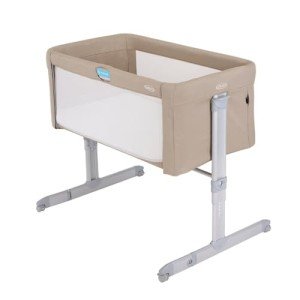11 Creative Ways To Write About Bedside Cot For Nursing
The Benefits of Using a Bedside Cot for Nursing: A Comprehensive Guide
Over the last few years, the concept of co-sleeping, particularly the use of bedside cots, has actually acquired much attention amongst new parents and caretakers. A bedside cot is a type of baby bed that is created to safely connect to the side of an adult bed, offering a safe sleeping environment for infants while promoting ease of access for breastfeeding mothers. This post will check out the numerous benefits of bedside cots for nursing, different types available, considerations for selecting one, and frequently asked concerns.
The Advantages of Bedside Cots for Nursing
1. Improved Accessibility
One of the most substantial benefits of a bedside cot is the ease of access it offers. Nursing mothers can simply reach over to choose up their baby without the need to stand up or move far from bed. This benefit enables:
- Quick night feedings
- Increased comfort for the mom
- Lowered danger of disturbances to both mother and baby during nighttime care
2. Promotes Bonding
Nursing is more than simply a means of nourishment; it is likewise a chance for moms to bond with their infants. A bedside cot facilitates this connection by permitting mothers to preserve close distance to their babies during sleep. This closeness can result in:
- Enhanced emotional connection
- Increased milk production due to frequent nursing
- A complacency for the infant
3. Motivates Extended Breastfeeding
The convenience of having a bedside cot motivates longer breastfeeding durations. Moms are more likely to follow their baby's feeding hints and respond quickly when they can easily access their kid. The benefits of prolonged breastfeeding consist of:
- Improved dietary intake for the baby
- Boosted developmental advantages
- Enhanced immunities through breast milk
4. Supports Safe Sleep Practices
Bedside cots are created with security in mind, allowing parents to keep close guidance over their sleeping infant. By Bedside Cot For Comfortable Sleep to safe sleep recommendations— such as placing the baby on their back to sleep and ensuring a firm mattress— parents can produce a much safer environment. Functions that add to security may include:
- Breathable sides to avoid suffocation
- Sturdy, non-toxic products
- Adjustable heights to match the adult bed
5. Versatile Use
A bedside cot can work as both a crib and a co-sleeping arrangement. Numerous models are adjustable in height or can be completely separated for use as a standalone crib when the child ages. This flexibility provides long-term use and value.
Kinds Of Bedside Cots
Bedside cots come in different designs and styles. Below are some common types:
Type
Description
Co-Sleeping Cribs
Full-sized cribs that can be securely attached to the side of the parents' bed.
Bassinet-style Cots
Smaller, portable cots that fit beside the bed and are lightweight for easy transportation.
Convertible Baby Beds
Cots that transform into various types of beds as the child grows, typically consisting of toddler and youth bed options.
Foldable Playards
These can be utilized as both a sleep area and a play location, quickly stored when not in use.
Considerations When Choosing a Bedside Cot
When selecting a bedside cot, parents need to think about numerous crucial factors:
Safety Features
- Try to find mesh sides for ventilation.
- Ensure that the cot satisfies security standards and guidelines.
Ease of Use
- Look for adjustable height settings to line up with your bed.
- Think about how quickly the cot can be moved if required.
Size and Space
- Ensure there suffices space in the bed room for the cot.
- Choose a crib that fits easily without taking excessive room.
Mobility
- If travel is regular, consider a light-weight design that can be quickly folded and transferred.
Resilience and Material
- Choose for top quality materials that use sturdiness and are easy to tidy.
Regularly Asked Questions
1. Are bedside cots safe for sleeping?
Yes, when used correctly and following security guidelines, bedside cots are normally safe for infants to sleep in. Constantly guarantee that the cot is safely attached to the adult bed which there are no spaces.
2. Can I use a bedside cot for a newborn?
Most bedside cots are created for newborns and can accommodate them safely. Always check the producer's recommendations for weight limits and age viability.
3. How can I ensure my baby's security while utilizing a bedside cot?
To guarantee security, constantly put your baby on their back to sleep and regularly inspect that the cot is safely connected to your bed. Keep a clutter-free sleeping environment.
4. When should I shift my baby from a bedside cot to a crib?
Constantly, parents transition their child to a crib when they are around 4 to 6 months old or when they begin to roll over regularly. Nevertheless, the specific timing depends on the baby's advancement.
5. Can I use a bedside cot for numerous babies?
Bedside cots are normally developed for single infants. If Bedside Crib For Attachment Parenting have twins or multiples, it's suggested to use different sleeping arrangements to guarantee safety.
Bedside cots offer many advantages for nursing mothers, including ease of access, security, and promoting a strong bond in between mom and kid. By picking the right kind of bedside cot and considering security functions, parents can create a nurturing environment for their infants. As the trend of co-sleeping continues to increase, supplying a safe and soothing setup is essential for the well-being of both baby and caregiver. With the ideal information and resources, parents can navigate this new chapter in their lives better ready than ever.
